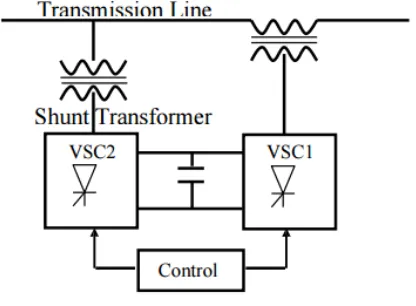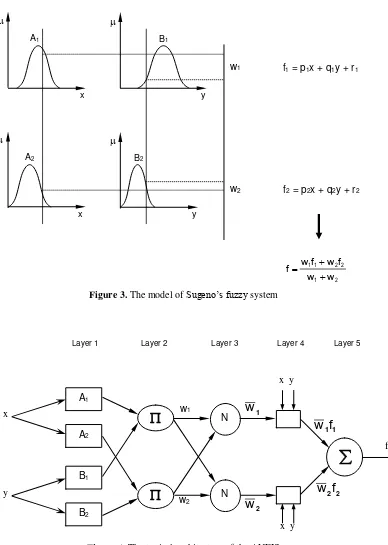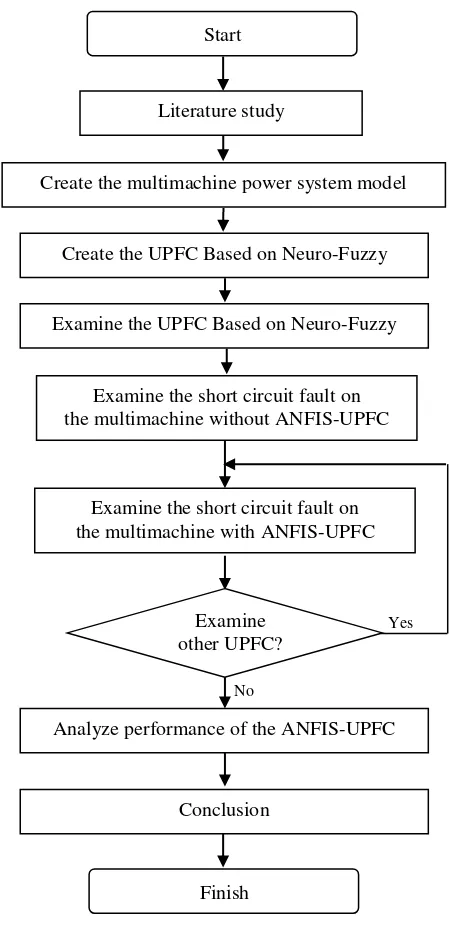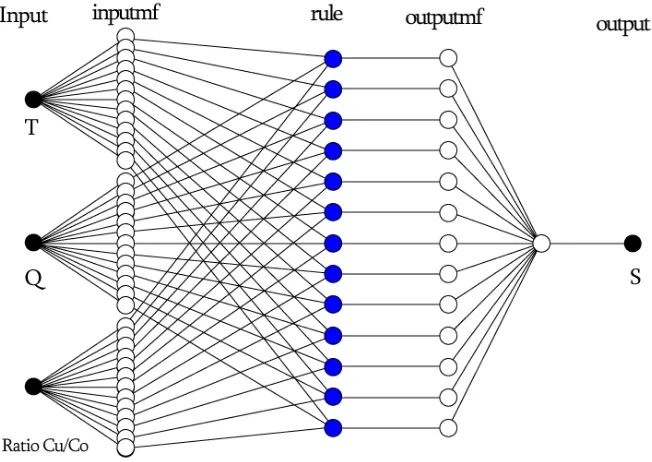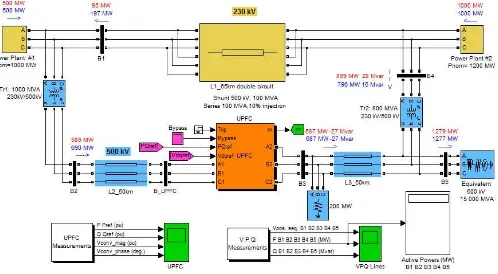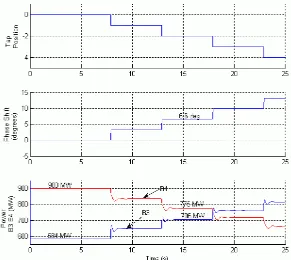Power Flow Optimization Using UPFC Based on Neuro-Fuzzy Method for Multi-machine
Power System Stability
Agus Jamal
Department of Electrical Engineering, Faculty of Engineering Universitas Muhammadiyah Yogyakarta, Yogyakarta, 55183, Indonesia.
Slamet Suripto
Department of Electrical Engineering, Faculty of Engineering Universitas Muhammadiyah Yogyakarta, Yogyakarta, 55183, Indonesia.
Ramadoni Syahputra
Department of Electrical Engineering, Faculty of Engineering Universitas Muhammadiyah Yogyakarta, Yogyakarta, 55183, Indonesia.
Abstract
This paper presents power flow optimization using UPFC based on neuro-fuzzy method for multi-machine power system stability. The controllers of power flow must be able to control both active and reactive power flow without reducing the stability of the power system. The recent power flow technology is the use of a Unified Power Flow Controller (UPFC). The common transmission line parameters, i.e. impedance, voltage, and phase angle, can be controlled simultaneously by the UPFC. UPFC could provide the different functions when the inserted voltages have different in magnitudes and phase angles. In the literature, some traditional techniques used in UPFC are still firmly with logic. These techniques have difficulties to multi-machine systems which is very dynamic. Therefore, the method based on neuro-fuzzy is implemented to the adaptive UPFC for adaptively controlling the power flow in dynamic multi-machine system in this study. The three phase fault is done to the multi-machine system. The adaptive neuro-fuzzy UPFC controller show that the overshoot occurred during the fault is low.
Keywords— Power flow, optimization, power system stability, UPFC, fuzzy logic controller, neural networks.
INTRODUCTION
In recent decade, modern power systems are characterized by extensive system interconnections and increasing of capacity [1]-[5]. There is dependence on control for optimum utilization of existing resources. The supply of economic and reliable of electric energy is a major determinant of industrial progress and consequent rise in the standard of living. The electrical power systems growth in the next will rely on increasing the capability of existing power transmission systems rather than building the new power transmission lines and the power
stations for an economical and an environmental reasons [6]-[8]. The need of the new controllers for power flow, which is capable of increasing the power transmission reliability and controlling the power flow through the predefined corridors, will be increased due to the deregulation of the markets electricity energy [9]-[12]. In 1980s, the Flexible Alternating Current Transmission Systems (FACTS) is an evolving technology based solution to help the electric utilities fully utilize their power transmission assets [13]. The devices of FACTS enhance the stability of the electric power system with its fast control characteristics and continuous compensating capability. The main objectives of FACTS are the controlling of the load flow and increasing the capacity of power transmission of the existing transmission lines [14]-[17].
The utilization of the power system comes into optimal condition. The controllability of the power system is increased with these aims. The Unified Power Flow Controller (UPFC) is the member of FACTS device [18]-[19]. It has emerged for the controlling and the optimization of load flow in the power transmission systems [20]-[25]. The UPFC formed of the combination of two other FACTS devices namely as Static Synchronous Compensator (STATCOM) and the Static Synchronous Series Compensator (SSSC). The STATCOM and SSSC are connected to each other by a common DC link, which is a typical storage capacitor. The all parameters of the electrical power transmission line, i.e. voltage, impedance, and phase angle can be control simultaneously by the UPFC. In addition, it can perform the control function of the power transmission line real/reactive power flow, UPFC bus voltage and the shunt-reactive-power flow control [26].
are used in UPFC models. A fuzzy inference system (FIS), which is described in matrix form, is recommended and used to improve the dynamic control of real and reactive power [27]-[29]. The fuzzy logic controllers (FLC) based on Mamdani type fuzzy logic are used in the study. One of the controllers is proportional fuzzy logic controller while the other is Hybrid fuzzy logic UPFC. The selection of the best location for UPFC is studied and composite-criteria based fuzzy logic is used to evaluate the network contingency ranking [30]-[32]. The power fluctuation is damped rapidly and the reactive power is minimized as possible by using several time constants. There is no value changed in the active power. The control method of variable interval-fuzzy-mutual is used in the mechanism of control in the UPFC [33]-[34]. In the results, there is a high overshoot occurred both real power and bus voltage during the three phase faults applied. The active power is increased but there is no changed in the reactive power. The performance of UPFC is observed by the three different controllers [35]-[37]. In results of the study, the variation of the real power direction can be observed easily. The reactive power is kept at zero because of there is no reactive power in the power system. In our study, the capability of UPFC on controlling of the power flow and the effectiveness of controllers on performance of UPFC in the power transmission line are performed by using different control mechanisms. The controllers are based on PI and neuro-fuzzy controllers. In the fuzzy logic controller (FLC), Takagi-Sugeno Inference System is used in the decision making process and “Weighted Average” method. The special case of Mamdani model is used in the process of defuzzification. The UPFC model is created in Matlab-Simulink software.
Power Flow Optimization
The power flow optimization methods are broadly classified as traditional and intelligent based method. The traditional methodologies include the popular techniques like Newton method, Gradient method, Quadratic Programming method, Linear Programming method and Interior point method. The intelligent based methodologies include the recently developed and popular methods like Ant Colony, Genetic Algorithm, and Particle swarm optimization.
In a power flow optimization method, the values of all of the control variables need to be found so as to optimize as an objective function. It is also important that the common problem definition with clearly stated objectives be given at the onset. The solution quality is depends on the accuracy of the model that are studied. The objectives function must be modeled and its practicality with possible solutions.
used as it reflects the current economic dispatch practice and importantly cost related aspect is always ranked high among operational requirements in an electrical power systems. A power flow optimization aims to optimize a certain objective, subject to the network power flow equations and equipment operating limits. The optimum condition is obtained by adjusting the available controls to minimize an objective function subject to specified operating and security requirements. Some objective functions can be identified as below:
1. Active power objectives, i.e.,
a. Economic dispatch (losses,minimum cost, power generation or transmission losses);
b. Environmental dispatch; and c. Maximum power transfer; 2. Reactive power objectives, i.e.,
a. Power loss minimization; and b. MVAr loss minimization; 3. General goals, i.e.,
a. Minimum deviation from a target schedule; b. Minimum control shifts to alleviate violations; and c. Least absolute shift representation of control shift. Among the above, the following objectives are most commonly used, i.e.,
1. Active power cost optimization; 2. Active power loss minimization; and
3. Reactive power planning to minimize the cost of reactive power support.
UPFC in Multi-machine Power System
Figure 1. Components of UPFC
Typical of UPFC in power system is shown in Figure 2. Each UPFC converter can separately generate or absorb reactive power. This position enables the free flow of active power in either direction between the AC terminals of the 2 converters. The series branch of the UPFC controls active and reactive load flows in the transmission line by the amplitude and phase angle of the series injected voltage. The active power controller can significantly affect the reactive power flow and vice versa.
Figure 2. Typical of UPFC in power system
In order to improve the performance of the UPFC, the interaction between the active and reactive load flow control system must be reduced. A number of investigations have been carried out to demonstrate the capabilities of UPFC as an effective load flow control [4], providing voltage control [15],
transient stability enhancement [16], and oscillation damping [17]-[19]. The strong dynamic interaction exists between the active and reactive power flows through a transmission line when they are controlled by series injected voltage vs of the UPFC has been reported in the literature. UPFC is highly nonlinear because it consists of converters, transformers, filters and surge arrestors.
Adaptive Neuro-Fuzzy Method
Adaptive neuro-fuzzy approach has been became a popular method in control area during the last three decades, especially in power system. a brief description of the adaptive neuro-fuzzy inference system (ANFIS) is given in this part [4]-[15]. The basic structure of the type of fuzzy inference system could be seen as a model that maps input characteristics to input membership functions. Then it maps input membership function to rules to a set of output characteristics. Finally it maps output characteristics to output membership functions.
Figure 3. The model of Sugeno’s fuzzy system
Figure 4. The typical architecture of the ANFIS
Figure 3 shows the model of Sugeno’s fuzzy system while Figure 3 shows the typical architecture of the ANFIS. The network is consisting of inputs, with N neurons in the input layer and F input membership functions for each input, with F*N neurons in the fuzzification layer. In the inference and defuzzification layers, there are FN rules with FN neurons while one neuron in the output layer. In order to simplicity, it is
If x is A1 and y is B1, Then f1 = r1 (1) If x is A2 and y is B2, Then f2 = r2 (2)
The output of the node i-th in layer n of ANFIS architecture is denoted as On,i.
Layer 1. Every node i in this layer is a square node with the function of node are:
A1
A2
B1
B2
xy
N
N
fx y
x y
2
w
1
w
w1w2
1 1
f
w
2 2
f
w
Layer 1 Layer 2 Layer 3 Layer 4 Layer 5
A1
A2
B1
B2
x
x
y
y
w1
w2
f1 = p1x + q1y + r1
f2 = p2x + q2y + r2
2 1
2 2 1 1
w w
f w f w
where x is the input of node-i, and Ai is the linguistic label which is associated with this node function. Commonly Ai(x) is chosen to be bell-shaped with maximum equal to 1 and minimum equal to 0, such as the generalized bell function below: i i i A
2b
a
c
x
1
1
(x)
μ
(5)The Parameters in this layer is called as the premis parameters. Layer 2. In this layer, every node is a circle node labeled Π which multiplies the incoming signals and sends the product out. The equation of this layer is:
�� = wi = Ai(x) x B(y), i = 1, 2. (6)
Layer 3. In this layer, every node is a circle node labeled N. The node i-th calculates the ratio of i-th rule’s firing strength to the sum of all rules firing strengths:
2 1 i 3 i
w
w
w
w
O
, i = 1, 2. (7)The outputs of this layer of ANFIS will be called normalized firing strengths.
Layer 4. In this layer, every node i is a square node with a node function:
)
i i i i i i 4i
w
f
w
(p
x
q
y
r
O
(8)
where
w
i is the layer 3 output and {pi, qi, ri} is the parameter set. The Parameters in this layer is called as the consequent parameters.Layer 5. In this layer, the single node is a circle node labeled Σ that computes the overall output as the summation of all incoming signals. The equation of this layer is below,
i i5
i
w
f
O
(9)RESEARCH METHODOLOGY
The stages of this research are described in Fig. 5. The simulation test based on Matlab software package is selected in this work. The Matlab is used as the main engineering tool for performing modeling and simulation of multi-machine systems. Matlab has been chosen due to the powerful set of programming tools, signal processing, numerical functions, and convenient user-friendly interface in this software tools. In this study, it is specially developed the evaluation procedures which can be easily performed. This study also used Fuzzy logic Toolbox of Matlab to develop the ANFIS model with three inputs and single output as given in Fig. 7.
Figure 5. Stages of the research
SIMULATION RESULTS AND DISCUSSION Adaptive Neuro-Fuzzy for UPFC
The design of the Adaptive Neuro-Fuzzy for load flow control using UPFC is following three steps, i.e.:
a. Generation of the training data.
The limit of input parameters should be determined precisely. The parameters are obtained from sending end in a power transmission system network. Due to limited the availability of practical fault data of transmission lines, it is necessary to generate training data using simulation. In order to generate data for the typical power transmission system, a computer program have been designed to collecting training data for different faults. b. Selection of an appropriate Adaptive Neuro-Fuzzy
structure for a given application. Start
Literature study
Create the multimachine power system model
Create the UPFC Based on Neuro-Fuzzy
Examine the UPFC Based on Neuro-Fuzzy
Examine the short circuit fault on the multimachine without ANFIS-UPFC
Examine other UPFC?
Yes
No
Analyze performance of the ANFIS-UPFC
Conclusion
Finish
The various of Adaptive Neuro-Fuzzy have been designed for UPFC to extend stability limits by modulating generator excitation to provide damping to the oscillation of synchronous machine rotors relative to one another. The membership function as an inputs variable for UPFC is shown in Figure 6, while the structure of Adaptive Neuro-Fuzzy for UPFC is shown in Figure 7.
c. Training the Adaptive Neuro-Fuzzy.
Various configurations of power network were trained in order to establish an appropriate network with satisfactory performances.
Figure 6. Membership function of ANFIS-UPFC Inputs Variable
Figure 7. The structure of ANFIS for UPFC
UPFC Model in Multi-machine System
In this work, a model of a multi-machine power system in Matlab-Simulink software is developed. An UPFC in this system has been used to control the power flow in a 500 kV /230 kV transmission systems, as shown in Figure 8. The
MW is circulating in the loop. As can be seen in Figure 8, the transformer Tr2 is overloaded by 99 MVA. The simulation also illustrates how a UPFC can relieve this power congestion. The ANFIS-UPFC which is design in this study located at the right end of line L2 is used to control both the real and reactive powers at the 500 kV bus B3, as well as the voltage at bus
B_UPFC. The ANFIS-UPFC consists of two 100 MVA, IGBT-based, converters (one shunt converter and one series converter interconnected through a DC bus). By the ANFIS-UPFC system, the converter in series arrangement can inject a maximum of 10% of nominal line-to-ground voltage (28.87 kV) in series with line L2.
Figure 8. A UPFC model in power transmission systems
The symmetrical three phase fault is applied to the multi-machine system as shown in Figure 8. The converter in series arrangement is rated 100 MVA with a maximum voltage injection of 0.1 pu while the shunt converter is rated of 100 MVA. The shunt converter is set in voltage regulation mode while the series converter is set in power flow control mode. The ANFIS-UPFC dynamic responses to changes in load of power system from 587 MW to 687 MW are shown in Figure 9. The ANFIS-UPFC reference both real and reactive powers
Further results of this work are shown in Figure 10. In the figure, it has been shown that the ANFIS-UPFC dynamic response to changes in load of power system from 587 MW to 687 MW. The figure also shows the controllability region of ANFIS-UPFC. The simulation results of ANFIS-UPFC for real power through bus B3 and B4 with tap position changes of PST which is shown in Figure 8, it can be seen that the ANFIS-UPFC is able to provide a response that controls the load flow. As can be seen in Figure 10 the action of ANFIS-UPFC is very attractive in damping power oscillations. In this design also included the role of adaptive neuro-fuzzy with FIS structure in order to control the generator in the event of changes in the electrical load so that power oscillations that occur can take place in a short time.
CONCLUSION
In this work, the adaptive neuro-fuzzy based method is applied to the UPFC for controlling the power flow in multi-machine electric power transmission system. The symmetrical three phase fault is applied to the multi-machine system in order to show the robustness of the ANFIS-UPFC. The results simulation is taken to be consideration of adaptive neuro-fuzzy controller. The controller has shown a low overshoot occurred during the fault in results. By results of simulation, it has been shown that ANFIS-UPFC improves the system performance under the transient and the normal conditions. However, ANFIS-UPFC can control the power flow in the multi-machine power system effectively.
ACKNOWLEDGEMENTS
The author is gratefully acknowledges the contributions of the Ministry of Research, Technology, and Higher Education, Republic of Indonesia, for funding in this research.
REFERENCES
[1] Syahputra, R., (2012), “Fuzzy Multi-Objective Approach for the Improvement of Distribution Network Efficiency by Considering DG”, International Journal of Computer Science & Information Technology (IJCSIT), Vol. 4, No. 2, pp. 57-68.
[2] Syahputra, R., Soesanti, I. (2017). Performance Analysis of a 2 kW Wind Turbine in the Southern Beach of Bantul. TELKOMNIKA, 15(1), pp. 28-35.
[3] Syahputra, R., (2012), “Distributed Generation: State of the Arts dalam Penyediaan Energi Listrik”, LP3M UMY, Yogyakarta, 2012.
[4] Soedibyo, Ashari, M., Syahputra, R. (2014), Power loss reduction strategy of distribution network with distributed generator integration. 1st International Conference on Information Technology, Computer, and Electrical Engineering (ICITACEE) 2014, UNDIP Semarang, pp. 404 – 408.
[5] Syahputra, R., Robandi, I., Ashari, M. (2014). “Optimal Distribution Network Reconfiguration with Penetration of Distributed Energy Resources”, Proceeding of 2014
1st International Conference on Information Technology, Computer, and Electrical Engineering (ICITACEE) 2014, UNDIP Semarang, pp. 388 - 393. [6] Syahputra, R., Robandi, I., Ashari, M. (2014).
Optimization of Distribution Network Configuration with Integration of Distributed Energy Resources Using Extended Fuzzy Multi-objective Method. International Review of Electrical Engineering (IREE), 9(3), pp. 629-639.
[7] Syahputra, R., Soesanti, I., Ashari, M. (2016). Performance Enhancement of Distribution Network with DG Integration Using Modified PSO Algorithm. Journal of Electrical Systems (JES), 12(1), pp. 1-19. [8] Syahputra, R. (2016). Application of Neuro-Fuzzy
Method for Prediction of Vehicle Fuel Consumption. Journal of Theoretical and Applied Information Technology (JATIT), 86(1), pp. 138-149.
[9] Syahputra, R., Robandi, I., Ashari, M. (2015). Performance Improvement of Radial Distribution Network with Distributed Generation Integration Using Extended Particle Swarm Optimization Algorithm. International Review of Electrical Engineering (IREE), 10(2). pp. 293-304.
[10] Syahputra, R., Robandi, I., Ashari, M., (2012), “Reconfiguration of Distribution Network with DG Using Fuzzy Multi-objective Method”, International Conference on Innovation, Management and Technology Research (ICIMTR), May 21-22, 2012, Melacca, Malaysia.
[11] Jamal, A., Syahputra, R. (2012), “Adaptive Neuro-Fuzzy Approach for the Power System Stabilizer Model in Multi-machine Power System”, International Journal of Electrical & Computer Sciences (IJECS), Vol. 12, No. 2, 2012.
[12] Syahputra, R., (2016), “Transmisi dan Distribusi Tenaga Listrik”, LP3M UMY, Yogyakarta, 2016. [13] Syahputra, R., Robandi, I., Ashari, M. (2014).
Performance Analysis of Wind Turbine as a Distributed Generation Unit in Distribution System. International Journal of Computer Science & Information Technology (IJCSIT), Vol. 6, No. 3, pp. 39-56.
[14] Jamal, A., Suripto, S., Syahputra, R. (2015). Multi-Band Power System Stabilizer Model for Power Flow Optimization in Order to Improve Power System Stability. Journal of Theoretical and Applied Information Technology, 80(1), pp. 116-123.
[15] Syahputra, R., Robandi, I., Ashari, M. (2015). Reconfiguration of Distribution Network with DER Integration Using PSO Algorithm. TELKOMNIKA, 13(3). pp. 759-766.
Theoretical and Applied Information Technology (JATIT), 91(2), pp. 249-256.
[17] Syahputra, R., Soesanti, I. (2016). An Optimal Tuning of PSS Using AIS Algorithm for Damping Oscillation of Multi-machine Power System. Journal of Theoretical and Applied Information Technology (JATIT), 94(2), pp. 312-326.
[18] Soesanti, I., Syahputra, R. (2016). Batik Production Process Optimization Using Particle Swarm Optimization Method. Journal of Theoretical and Applied Information Technology (JATIT), 86(2), pp. 272-278.
[19] Jamal, A., Syahputra, R. (2016). Heat Exchanger Control Based on Artificial Intelligence Approach. International Journal of Applied Engineering Research (IJAER), 11(16), pp. 9063-9069.
[20] Syahputra, R. (2015). Characteristic Test of Current Transformer Based EMTP Shoftware. Jurnal Teknik Elektro, 1(1), pp. 11-15.
[21] Syahputra, R., Soesanti, I. (2015). Power System Stabilizer model based on Fuzzy-PSO for improving power system stability. 2015 International Conference on Advanced Mechatronics, Intelligent Manufacture, and Industrial Automation (ICAMIMIA), Surabaya, 15-17 Oct. 2015 pp. 121 - 126.
[22] Syahputra, R., Robandi, I., Ashari, M., (2013), “Distribution Network Efficiency Improvement Based on Fuzzy Multi-objective Method”. International Seminar on Applied Technology, Science and Arts (APTECS). 2013; pp. 224-229.
[23] Syahputra, R., Soesanti, I. (2015). “Control of Synchronous Generator in Wind Power Systems Using Neuro-Fuzzy Approach”, Proceeding of International Conference on Vocational Education and Electrical Engineering (ICVEE) 2015, UNESA Surabaya, pp. 187-193.
[24] Syahputra, R., (2013), “A Neuro-Fuzzy Approach For the Fault Location Estimation of Unsynchronized Two-Terminal Transmission Lines”, International Journal of Computer Science & Information Technology (IJCSIT), Vol. 5, No. 1, pp. 23-37.
[25] Jamal, A., Syahputra, R. (2013). UPFC Based on Adaptive Neuro-Fuzzy for Power Flow Control of Multimachine Power Systems. International Journal of Engineering Science Invention (IJESI), 2(10), pp. 05-14. [26] Syahputra, R. (2010). Fault Distance Estimation of Two-Terminal Transmission Lines. Proceedings of International Seminar on Applied Technology, Science, and Arts (2nd APTECS), Surabaya, 21-22 Dec. 2010, pp. 419-423.
Applied Engineering Research (IJAER), 10(6), pp. 14573-14586.
[28] Syahputra, R., Soesanti, I. (2016). DFIG Control Scheme of Wind Power Using ANFIS Method in Electrical Power Grid System. International Journal of Applied Engineering Research (IJAER), 11(7), pp. 5256-5262.
[29] Jamal, A., Suripto, S., Syahputra, R. (2016). Performance Evaluation of Wind Turbine with Doubly-Fed Induction Generator. International Journal of Applied Engineering Research (IJAER), 11(7), pp. 4999-5004.
[30] Syahputra, R., Soesanti, I. (2016). Design of Automatic Electric Batik Stove for Batik Industry. Journal of Theoretical and Applied Information Technology (JATIT), 87(1), pp. 167-175.
[31] Jamal, A., Syahputra, R. (2014). Power Flow Control of Power Systems Using UPFC Based on Adaptive Neuro Fuzzy. IPTEK Journal of Proceedings Series. 2014; 1(1): pp. 218-223.
[32] Syahputra, R., Soesanti, I. (2016). Power System Stabilizer Model Using Artificial Immune System for Power System Controlling. International Journal of Applied Engineering Research (IJAER), 11(18), pp. 9269-9278.
[33] Syahputra, R. (2017), “Distribution Network Optimization Based on Genetic Algorithm”. Journal of Electrical Technology, 1(1), pp. 1-12.
[34] Soesanti, I. (2017), “Solving the Traveling Salesman Problem Using Neural Network Method”. Journal of Electrical Technology, 1(1), pp. 13-19.
[35] Syahputra, R., Robandi, I., Ashari, M., (2011), “Modeling and Simulation of Wind Energy Conversion System in Distributed Generation Units”. International Seminar on Applied Technology, Science and Arts (APTECS). 2011; pp. 290-296.
[36] Syahputra, R., Robandi, I., Ashari, M., (2011), “Control of Doubly-Fed Induction Generator in Distributed Generation Units Using Adaptive Neuro-Fuzzy Approach”. International Seminar on Applied Technology, Science and Arts (APTECS). 2011; pp. 493-501.
